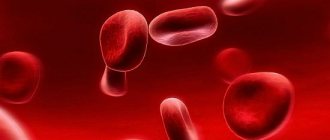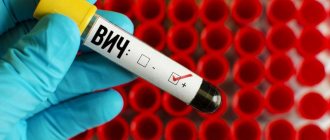" Blood tests
A blood test is one of the most common tests that any person has to undergo quite often. It allows you to determine the composition of the blood, the ratio of various formed elements and even the presence of infections in the body.
In order for the results of the analysis to be as correct as possible, you need to prepare a little for blood sampling: do not consume very fatty foods or alcoholic beverages the day before. And on the day of the study, it is better to abstain from food altogether, limiting yourself to clean water. Of course, after you have passed the exam, you can already eat. The analysis is usually carried out in the morning.
However, even with absolutely correct blood sampling and following all recommendations, it happens that the blood taken cannot be used for research. A problem such as hemolysis occurs especially often.
- 2 Why is hemolysis possible when taking a blood test?
- 3 How to insure yourself against hemolysis when taking tests?
Rules for taking blood
A person planning to donate blood for analysis from a vein or finger must ask how to do it correctly.
You need to make sure that some tests require obtaining blood from a vein rather than a finger for a number of reasons:
- When taken from a finger, some of the blood cells degrade and microscopic clots form, making analysis difficult. To avoid repeated blood sampling, it is recommended to take material from a vein;
- To collect blood from a vein, safe disposable vacuum systems complying with international standards are used;
- Some tests cannot be performed on blood taken from a finger prick;
- The process of drawing blood from a vein lasts several seconds. It is safe and painless, which is important when taking samples from small children;
- Highly qualified medical workers are allowed to take blood from a vein.
What you need to know to successfully donate blood for sugar
In order to take a blood sugar test, no special preliminary preparation is needed. It is necessary to lead your usual lifestyle, eat normally, consume enough carbohydrates, i.e. do not starve. During fasting, the body begins to release glucose from its stores in the liver, and this can lead to a false increase in glucose levels in the test.
It is advisable to take a blood sugar test, like all other tests, early in the morning on an empty stomach.
It is in the early morning hours (before 8 am) that the human body has not yet begun to work at full strength; organs and systems peacefully “sleep” without increasing their activity. Later, mechanisms are launched aimed at their activation and awakening. One of them is increased production of hormones that increase blood sugar levels.
Many people are interested in why a blood sugar test needs to be taken on an empty stomach. The fact is that even small amounts of water activate our digestion, the stomach, pancreas, and liver begin to work, and all this is reflected in the level of sugar in the blood.
Not all adults know what fasting is. Fasting means not consuming food or water 8-14 hours before the test. As you can see, this does not mean at all that you need to fast from 6 pm, or even worse, all day if you are going to take the test at 8 am.
Basic rules of preparation
- do not fast beforehand, lead a normal lifestyle;
- before taking the test, do not eat or drink anything for 8–14 hours;
- do not drink alcoholic beverages for three days before the test;
- It is advisable to come for analysis in the early morning hours (before 8 am);
- A few days before the test, it is advisable to stop taking medications that increase blood sugar levels. This only applies to medications taken temporarily; there is no need to stop those you take on an ongoing basis.
Before taking a blood sugar test, you should not:
- Smoking. During smoking, the body produces hormones and biologically active substances that increase blood sugar levels. In addition, nicotine constricts blood vessels, which complicates blood sampling.
- Brush your teeth. Most toothpastes contain sugars, alcohols, or herbal extracts that increase blood glucose levels.
- Do intense physical activity, go to the gym. The same applies to the road to the laboratory itself - there is no need to rush and rush, forcing the muscles to actively work, this will distort the result of the analysis.
- Carry out diagnostic interventions (FGDS, colonoscopy, radiography with contrast, and even more so complex ones, such as angiography).
- Perform medical procedures (massage, acupuncture, physiotherapy), they significantly increase blood sugar levels.
- Visit the bathhouse, sauna, solarium. It is better to postpone these activities until after the analysis.
- Be nervous. Stress triggers the release of adrenaline and cortisol, which raise blood sugar levels.
What is this disease
Blood consists of many components: proteins, platelets, red blood cells, fibrins and others. It is responsible for the delivery of nutrients and oxygen to all internal organs and tissues. In order to prevent serious blood loss due to vascular damage, a process is provided for the formation of blood clots when tissue factor enters the bloodstream. If this process is disrupted, this indicates the presence of a disease.
Poor blood clotting is associated with a lack of certain enzymes. There is a decreased production of platelets. This pathology is dangerous to human health and life. If the damage to the blood vessels is severe, severe blood loss can lead to death.
Depending on the provoking factor, there may be several answers to the question of what the disease is called:
- If the pathology is associated with a lack of fibrinogen in the blood, then the coagulation disorder is called fibrinopenia.
- When a hereditary factor plays a key role, the disease is usually called hemophilia. Mostly men suffer from this problem.
- The disease caused by a lack of platelets is called thrombocytopenia.
These diseases have similar causes and are characterized by the same symptoms.
Normal blood clotting in a child
The main causes of poor blood clotting in children lie in pathological processes. The vast majority of them are hereditary, with autoimmune diseases and lesions of the hepato-biliary system in second place. Once the doctor discovers the cause, treatment should be started immediately.
Reduced or low activity of the blood clotting system occurs in the following pathologies.
- Hemophilia. This disease occupies a leading position in reducing the efficiency of hemostasis. It is caused by a deficiency of blood factors 8, 9, 11, which are responsible for clotting. The result of this is a decrease in all points of the coagulogram. The pathology is hereditary and affects mainly men.
- Von Willebrand's disease. Some doctors call the pathology pseudohemophilia. This is a less dangerous disease, and it equally often affects people of both sexes. Nosebleeds and bleeding from the gums are typical, and uterine hemorrhages may occur in girls.
- Thrombocytopenia. The triggering factor is considered to be an allergic process in response to therapy with anti-inflammatory drugs and chemotherapy. Treatment of the disease is possible not only in the hematology department, but also in the allergy hospital.
- Overdose of drugs. One of the most common causes of disruption of the hemostatic system. Drugs such as paracetamol or aspirin-containing drugs play a role here. There is a decrease in the level of platelets and red blood cells. The condition is manifested by subcutaneous hemorrhages, bleeding of the gastrointestinal tract. If you do not stop taking these medications, hemorrhages in the brain, even death, are possible.
- Liver dysfunction. They are caused by diseases such as hepatitis and cirrhosis, which occurs not only in adults. The production of hepatic coagulation factors is reduced.
- DIC syndrome is considered an extremely dangerous condition. With it, the influence of all blood clotting factors is reduced, sometimes it is completely absent. This pathology develops against the background of severe infectious processes, bleeding, surgical interventions, burns or traumatic injuries.
Increased blood clotting in children is a hereditary pathology. Thrombosis occurs most often in the following pathologies.
- Antiphospholipid syndrome. The blood of children contains so-called antiphospholipid antibodies. Clinical manifestations of the pathology correspond to thromboembolism. Females suffer from infertility due to the fact that they cannot bear a child.
- Trobophilia group. These include diseases such as Leiden factor, deficiency of proteins C, S, and antithrombin. Pathologies of this group also include an excess of factors 8, 11, lipoprotein and hyperhomocysteinemia. Prothrombin mutations are also noted. All of the above thrombophilic processes lead to the development of thrombosis. It is important to note that in childhood thrombosis is a rare phenomenon; bleeding is much more common. For the appearance of thrombotic pathologies, certain conditions are necessary - severe pathologies, severe physical inactivity or bed rest, regular venous punctures.
- Malignant neoplasms.
- Venous diseases.
If close relatives die from thrombotic processes, there is a high probability that the child will inherit mutated or pathological genes.
source
Have you been struggling with HYPERTENSION for many years without success?
Head of the Institute: “You will be amazed at how easy it is to cure hypertension by taking it every day.
Everyone knows that prevention of pathologies of the cardiovascular system can prevent many dangerous diseases, but they pay little attention to such an important point as blood viscosity indicators. But absolutely all processes occurring in the cells and organs of our body depend on the state of this living environment.
Its main function is to transport respiratory gases, hormones, nutrients and many other substances. When the properties of the blood change, which include thickening, acidification or increasing the level of sugar and cholesterol, the transport function is significantly disrupted and redox processes in the heart, blood vessels, brain, liver and other organs proceed abnormally.
That is why preventive measures to prevent heart and vascular diseases must include regular monitoring of blood viscosity indicators. In this article we will introduce you to the causes of thick blood (high blood viscosity syndrome, or hyperviscose syndrome), symptoms, complications, methods of diagnosis and treatment. This knowledge will help you prevent not only many diseases of the cardiovascular system, but also their dangerous complications.
Our readers successfully use ReCardio to treat hypertension. Seeing how popular this product is, we decided to bring it to your attention. Read more here...
Blood consists of plasma (the liquid part) and formed elements (blood cells), which determine its thickness. The hematocrit level (hematocrit number) is determined by the ratio between these two blood environments. Blood viscosity increases with increasing levels of prothrombin and fibrinogen, but can also be provoked by an increase in the level of red blood cells and other blood cells, hemoglobin, glucose and cholesterol. That is, with thick blood, the hematocrit becomes higher.
This change in the blood formula is called high blood viscosity syndrome, or hyperviscose syndrome. There are no uniform indicators of the norm for the parameters described above, since they change with age.
An increase in blood viscosity leads to the fact that some blood cells cannot fully perform their functions, and some organs stop receiving the substances they need and cannot get rid of waste products. In addition, thick blood is harder to push through the vessels, is prone to the formation of blood clots, and the heart has to make great efforts to pump it. As a result, it wears out faster, and a person develops its pathologies.
Increased blood density can be detected using a general blood test, which will show an increase in hematocrit caused by an increase in the level of formed elements and hemoglobin. Such an analysis result will certainly alert the doctor, and he will take the necessary measures to identify the cause and treat the syndrome of high blood viscosity. Such timely measures can prevent the development of a whole bunch of diseases.
Blood is the basis of the body’s vital functions; all processes occurring inside it depend on its viscosity and composition.
The viscosity of human blood is regulated by a number of factors. The most common predisposing factors for the development of hyperviscosity syndrome are:
- increased blood clotting;
- increase in the number of red blood cells;
- increase in platelet count;
- increased hemoglobin levels;
- dehydration;
- poor absorption of water in the large intestine;
- massive blood loss;
- acidification of the body;
- hyperfunction of the spleen;
- enzyme deficiency;
- lack of vitamins and minerals that are involved in the synthesis of hormones and enzymes;
- irradiation;
- large amounts of sugar and carbohydrates consumed.
Typically, increased blood viscosity is caused by one of the above disorders, but in some cases the composition of the blood changes under the influence of a whole range of factors.
The causes of such disorders are the following diseases and pathologies:
- foodborne illnesses and diseases accompanied by diarrhea and vomiting;
- hypoxia;
- some forms of leukemia;
- antiphospholipid syndrome;
- polycythemia;
- diabetes mellitus and diabetes insipidus;
- diseases accompanied by an increase in protein levels in the blood (Waldenström macroglobulinemia, etc.);
- myeloma, AL amyloidosis and other monoclonal gammopathies;
- thrombophilia;
- adrenal insufficiency;
- hepatitis;
- cirrhosis of the liver;
- pancreatitis;
- varicose veins;
- thermal burns;
- pregnancy.
Thick blood impedes blood flow and contributes to the development of cardiovascular diseases.
The symptoms of hyperviscosity syndrome largely depend on the clinical manifestations of the disease that caused it. Sometimes they are temporary and disappear on their own after the causes that provoked them are eliminated (for example, dehydration or hypoxia).
The main clinical signs of thick blood are the following symptoms:
- dry mouth;
- fast fatiguability;
- frequent drowsiness;
- absent-mindedness;
- severe weakness;
- depression;
- arterial hypertension;
- headache;
- heaviness in the legs;
- constantly cold feet and hands;
- numbness and tingling in areas with impaired blood microcirculation;
- nodules on the veins.
In some cases, hyperviscosity syndrome occurs hidden (asymptomatic) and is detected only after evaluating the results of a blood test.
High blood viscosity syndrome is not a disease, but in the presence of serious pathologies it can cause severe and dangerous complications. More often, blood thickens in older people, but in recent years this syndrome has been increasingly detected in middle-aged and young people. According to statistics, thick blood is more often observed in men.
The most dangerous consequences of hyperviscosity syndrome are a tendency to form blood clots and thrombosis. Usually small vessels are thrombosed, but there remains an increased risk that the clot will block a coronary artery or cerebral vessel. Such thromboses cause acute tissue necrosis of the affected organ, and the patient develops myocardial infarction or ischemic stroke.
Other consequences of thick blood may include the following diseases and pathological conditions:
- hypertonic disease;
- atherosclerosis;
- bleeding;
- intracerebral and subdural bleeding.
The degree of risk of complications of hyperviscosity syndrome largely depends on the underlying cause of its development. That is why the main goal of treating this condition and preventing its complications is to eliminate the underlying disease.
To identify hyperviscosity syndrome, the following laboratory tests are prescribed:
- Complete blood count and hematocrit. Allows you to determine the number of blood cells, hemoglobin level and their ratio to the total blood volume.
- Coagulogram. Gives an idea of the state of the hemostasis system, blood clotting, duration of bleeding and integrity of blood vessels.
- APTT. Allows you to evaluate the effectiveness of the internal and general coagulation pathways. Aimed at determining the level of plasma factors, inhibitors and anticoagulants in the blood.
Reasons for clotting
Hemolysis is the destruction of red blood cells in the blood, releasing hemoglobin. Hemolysis can be physiological (normal) and pathological. Physiological hemolysis occurs at the end of the red blood cell's life span, which lasts four months. With pathological hemolysis, red blood cells die prematurely. To prevent clotting, blood collected for testing is stabilized with preservatives.
The causes of hemolysis when taking blood from a finger and a vein lie entirely on the unqualified actions of medical personnel. Either the rules for taking a blood sample for analysis were violated, or the conditions for preserving biological material were not met.
During hemolysis, blood may clot immediately after it is taken, or after a short time, and the analysis will have to be retaken. Private clinics, whose paid services include blood tests, return money if the analysis fails.
Hemolysis during blood sampling from a vein occurs both due to the patient’s fault and due to unqualified actions of personnel.
The patient’s guilt boils down to failure to prepare for blood donation: eating fatty foods directly on the day of blood collection, or the day before. Fats emulsify the blood and cause a change in its colloidal properties. Red blood cells cannot live in such blood and die.
Hemolysis during blood sampling makes it impossible to perform tests and the need to repeat the procedure for obtaining biomaterial for analysis. So, in some cases it is necessary to analyze the level of bilirubin in the blood. This substance is synthesized from hemoglobin released during the breakdown of red blood cells, that is, hemolysis. Therefore, hemolysis during blood sampling for bilirubin makes the material unsuitable for analysis: the amount of bilirubin will be obviously overestimated.
Results of Blood Drawing Errors
The fault of the medical staff is as follows:
- Dirty test tube . Traces of materials from the previous analysis remained on the walls of the vessel. It’s good if hemolysis occurs immediately. Otherwise, distorted research results may be obtained;
- A preservative was not added to the test tube, or a solution of inappropriate concentration was prepared;
- High speed of blood sampling. The vacuum caused by rapid filling of the syringe leads to instantaneous destruction of red blood cells;
- Failure to comply with asepsis rules . When transfusing biological material from test tube to test tube, the activity of microorganisms can cause hemolysis;
- Failure to comply with transportation rules . Situations in which blood is collected in one place and examined in another are quite common. If the rules for packaging blood tubes are not followed, and they are subjected to shaking or vibration, which negatively affects blood cells;
- Violation of storage rules. Keeping blood tubes in a vibrating refrigerator contributes to the development of the cause of hemolysis. The destructive effects of direct sunlight and elevated temperatures, or freezing also contribute to the development of the causes of blood hemolysis.
What is hemolysis?
Hemolysis is a normal physiological process that occurs in the blood. Under the influence of this process, erythrocytes (red blood cells) burst and the hemoglobin contained in them comes out. Under natural conditions (inside a vessel), an erythrocyte lives on average 120 days. Then its “death” occurs - hemolysis.
When blood material is collected, it is mixed in a test tube with a special preservative, which is added precisely to prevent hemolysis. However, if the blood sampling technology is violated, then its clotting may occur after a short period of time or even immediately.
Unexpected hemolysis makes the blood unsuitable for testing and the analysis always has to be retaken. In one hundred percent of cases, this is either the fault of an inattentive health worker or violation of storage conditions. Many private clinics and laboratories even practice refunds for such failed analysis.
How to avoid
When collecting blood for analysis, it depends a little on the patient. The main thing is to choose a clinic that has a reliable reputation. In case of hemolysis of the sample, it can be taken again. But few people would be pleased to lose time, and in some situations, money, due to poor quality of service. It’s even worse if hemolysis occurs during blood sampling from an infant or child. The analysis procedure itself, especially from a vein, causes fear in children. It will be unpleasant for parents to watch the suffering of a baby whose veins are pierced several times.
To prevent such a situation, it is necessary to show interest in the working conditions of medical personnel. You should ask where and when the analysis will be carried out, how it will be transported and under what conditions it will be stored.
To avoid hemolysis of the blood sample being taken, as well as the cost of personal time and money for repeated analysis, it is best to take the procedure seriously and take care of the sterility of the instruments. It is a good idea to have a syringe, sterile gloves and a test tube with you. It is a good idea to personally control the addition of the preservative to the test tube.
How to submit biological material correctly?
In the absence of appropriate preparation before testing, the resulting sample may become unsuitable for study.
In laboratory diagnostics, blood from a vein is most often used - it is this material that provides practitioners with more detailed information about the biochemical processes occurring in the human body. You should start preparing for the biomaterial collection procedure three days before the appointed time:
- The consumption of alcoholic and sweet carbonated drinks is prohibited.
- Fatty, spicy and fried foods are excluded.
- Smoking, psycho-emotional stress and physical activity are limited.
A sample of biomaterial is taken in the morning - from 8.00 to 11.00. It is advisable for the patient to have dinner on the eve of the study no later than 19.00, and it is necessary to refuse breakfast - it is allowed to drink a glass of purified water without gas. The child can be fed 2 hours before the procedure.
Lack of preparation for the test may cause the blood to be unsuitable for testing.
Almost every person, when an illness appears, is faced with a blood test from a vein. Indeed, blood from a vein allows us to learn about most of the processes occurring in the human body. Thanks to this material, the doctor is able to immediately find out by deciphering the analysis result whether there is an inflammatory process in the body and what treatment methods will be more effective in this situation. But in order to obtain accurate information, blood must be donated in accordance with all rules. You should prepare for the test a couple of days before the appointed day. During this period, foods containing a high percentage of fat, as well as alcoholic beverages, are excluded from the diet. When donating blood from a vein, a person must have an empty stomach.
If these requirements are not met, there is a high risk of not only obtaining an incorrect result, but also the inability to conduct a blood test due to hemolysis.
What hemolysis is is often learned by the patient only when it turns out that the analysis failed due to blood clotting. Hemolysis is a natural process in which red blood cells undergo destruction, during which hemoglobin is released. It is this process that provokes blood clotting. You can avoid such troubles with the analysis by adhering to the preparation rules applied before taking the analysis.
And although most often the causes of hemolysis are hidden in improper preparation for the test, there are other reasons that can make blood unsuitable for testing.
Expiration dates and readiness dates for blood tests
The timing of blood tests is influenced by several factors:
- type of laboratory test;
- level of technological equipment of the laboratory;
- specifics of the study (number and properties of specified indicators for diagnosis).
The timing of blood tests also depends on the requirements and capabilities of the clinic. Some medical organizations are reducing the average shelf life of blood tests, while others are increasing them.
Most modern clinics, equipped with the latest medical equipment, conduct full examinations and provide blood test results within one day, and in some cases you can receive the test result in your hands within 1-2 hours. But at the same time, in most public clinics the same studies can be carried out within 5–7 days. It turns out that the timing of blood tests directly depends on the choice of laboratory and the cost of the study.
Certain generally established limits for the shelf life of blood tests are indicated. However, here, too, various variations can occur, when the period of blood tests can be shortened or increased. Typically, medical institutions inform their patients about the types of blood tests and their expiration dates in leaflets and on information stands.
Let us consider the timing of blood tests for the main types of studies in more detail.
Clinical (general) blood test
The most common analysis, and it is one of the most important diagnostic methods for therapeutic, gynecological, cardiological, urological, and endocrinological studies.
- The turnaround time for blood tests is 5 days.
- The validity period of the tests is 10–14 days.
Blood chemistry
Allows you to assess the functioning of the main internal organs, provides information about metabolic processes (carbohydrate, protein, lipid metabolism), and also allows you to determine the need for essential microelements.
- Ready time: 4–5 days.
- The shelf life of blood tests is 10–14 days.
Allergy blood test
Gives an idea of the state of the human immune system. Allows you to determine the presence of allergens that cause allergic reactions in the body.
- The turnaround time for blood tests is 5–7 days.
- Blood tests are valid for up to 1 month.
Hormonal studies
They assess the condition of the endocrine organs, help diagnose various hormonal changes and identify diseases of the pancreas, thyroid gland, gonads, and assess the state of fat metabolism.
- The turnaround time for tests is 5–10 days.
- Shelf life – up to 6 months.
Blood tests for HIV infection
They allow detection of antibodies that arise in the body during infection with the human immunodeficiency virus.
- Ready time: 4–5 days.
- Blood tests are valid for up to 6 months.
Blood test for syphilis (RW)
A special type of laboratory blood test. Allows you to determine the presence of a pathogen in the human body.
- The turnaround time for blood tests is 4–8 days.
- Shelf life – from 20 days to 3 months.
Blood tests for markers of viral hepatitis groups B, C, D, E
Laboratory tests to determine the presence of antibodies to hepatitis viruses.
- The turnaround time for tests is 4–5 days.
- Blood tests are valid for up to 3 months.
Blood sugar test
The main type of study for diagnosing diabetes mellitus.
- Ready time: 1–4 days.
- The shelf life of blood tests is 10–15 days.
Analysis for fungal and parasitic infections
Determines the presence of antibodies to protozoan parasites and fungi.
- The turnaround time for blood tests is 4-8 days.
- Tests are valid for up to 6 months.
You can take blood tests to check your own health at any private clinic, of which there are many in any city. However, the results of the analysis are for informational purposes only and cannot serve as a diagnosis of any disease. To obtain more detailed information and prescribe qualified treatment, you need to contact a specialist and get a face-to-face consultation with a good doctor. The timing of blood tests is limited, for this reason you should promptly contact a specialist for interpretation and advice. Otherwise, the tests will have to be retaken. We wish you good health.
Coagulation indicators and their norm
Bleeding time is the length of time during which a clot forms when the integrity of the skin is broken. This is a basic study that evaluates the function and condition of the vessel walls. In a healthy person, venous blood flows within 5–10 minutes, capillary blood flows within no more than 2 minutes. – coagulation protein, which is an important component of thrombin; normally it is 78-142%.
Thrombin time, or aPTT, is the period of time during which blood clotting occurs; it is 11-17.8 seconds.
Fibrinogen is a plasma protein responsible for the formation of a blood clot. Its normal content is 2.00 - 4.00 g/l; - 1.25-3.00 g/l.
Antithrombin is a specific protein that ensures the resorption of a blood clot.
Normal blood clotting in a child
Blood clotting in children is somewhat different from that in adults. This is due to the normal physiological processes of the body growing up. In order to determine the state of the hemostatic system and the risk of prolonged bleeding, tests are prescribed - coagulogram, INR and others. They make it possible to determine indicators such as clotting time, the amount of fibrinogen, platelets, and to identify blood clotting disorders in children.
The main criteria of the hemostatic system in children, their norm and interpretation.
- Prothrombin time makes it possible to establish pathologies such as hemophilia or DIC syndrome. The norm for children is 11-17 seconds.
- Thrombin time is 14-21 seconds. Results may vary slightly when determining the indicator in different laboratories.
- Clotting time is the period during which a blood clot forms. The norm is 2-5 minutes.
- Bleeding time is 2-4 minutes.
- Fibrinogen in children is 1-3 grams. Allows you to determine the functional performance of the hemostasis system.
- Prothrombin index.
- Antithrombin-3 is a regulator of blood coagulation function.
In newborns, as well as in infants or infants, the normal values of all shaped elements are somewhat different from those for adults. For example, hemoglobin can reach 160-220 g/l, and red blood cells 5-7x10 12 / l. However, they have slightly different shapes and sizes. The number of reticulocytes increases to 40%, and leukocytes to 10-20x10 9 / l.
In the first year of life, all blood parameters tend to normal, hemoglobin decreases to 120-140 g/l, red blood cells also drop, their shape and size stabilize. The number of all formed elements decreases and remains slightly elevated, the leukocyte formula shows lymphocytosis and monocytosis. Platelets are at the level of 200-300x10 9 /l.
Threat to pregnant women
Thrombophilia often occurs in expectant mothers due to complications that can occur during pregnancy.
This disease can cause miscarriage.
In pregnant women, the tendency to thrombophilia sharply increases, and if a woman has blood thickening before pregnancy, the disease intensifies while carrying a child. As a result, late toxicosis may occur, the placenta may detach, and miscarriage syndrome may develop. Premature labor pains may occur, and in some cases it ends in the death of the fetus.
All this happens due to the fact that the unborn child is fed through the placenta, which has many blood vessels. With thickened blood, it does not receive the necessary nutrients and oxygen, which leads to slower growth and development. To relieve these problems, doctors use blood thinners. They are given to women by injection.
Impact on the analysis result
Hemolysis can interfere with blood test determinations by releasing substances from red blood cells into the plasma or creating analytical interference.
With the breakdown of red blood cells, substances penetrate into the plasma that have a different appearance in the extracellular fluid than in the intracellular content of red blood cells. These substances can significantly affect the results when determining the analyte in the blood, since their concentration in erythrocytes is several times higher than in plasma (blood serum).
Plasma dilution
The intracellular fluid content of blood cells dilutes the concentration of the analyte contained in the plasma. We are talking, in particular, about glucose, bilirubin, Na and Cl.
Enzyme analysis of red blood cells
In the absence of glucose-6-phosphate dehydrogenase, glutathione reduction occurs. Red blood cells (their membrane) are susceptible to damage from reactive oxygen species.
Gama test
The Gama test is a diagnostic test (screening) for paroxysmal nocturnal hemoglobinuria (NPH). Red blood cells are incubated in serum acidified to pH 6.2, the acidic environment activates complement and pathological red blood cells are susceptible to hemolysis.
This method identifies proteins associated with the cell membrane and involved in the following processes:
- protection against the lytic effects of complement;
- The 2 proteins (MIRL and DAF) are designated according to the antibodies with which they specifically interact, CD-55 and CD-59.











